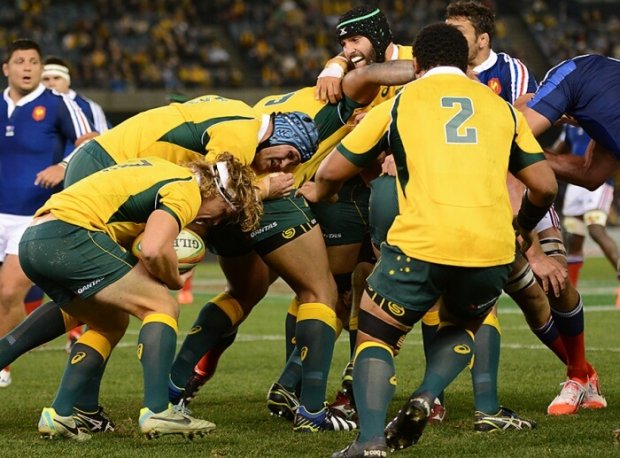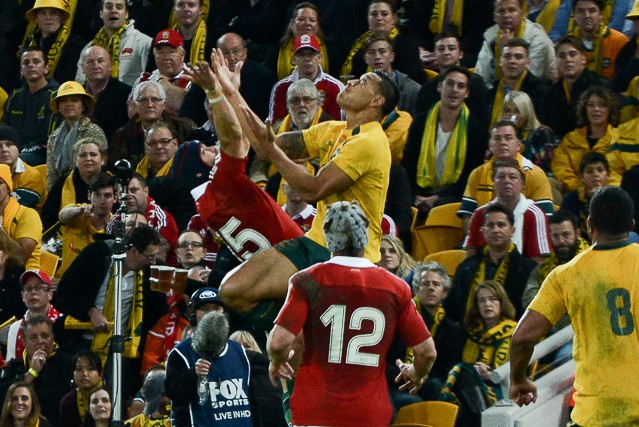So here’s a story about maul law reform we’ve been sitting on for a few weeks now.
Green & Gold Rugby’s unparalleled network of sources can tell you that moves have been afoot at the highest levels to more strictly enforce the existing laws on maul formation. The World Cup referees attended a pow-wow in France a few weeks ago. Our sources there tell us mauls were overwhelming the main topic of discussion.
The result is two World Rugby directives governing maul refereeing and a couple of other directives which, though attracting less attention right now, could be important on the field in the coming months.
Maul
The issue here is binding. First, referees were instructed that players joining the maul must do so alongside or behind the ball carrier. Of course, this has always been the law, it just hasn’t been policed effectively.
The relevant law here is 17.4 (c):
“Players joining the maul. Players joining a maul must do so from behind the foot of the hindmost team-mate in the maul. The player may join alongside this player [the hindmost team-mate]. If the player joins the maul from the opponents’ side, or in front of the hindmost team-mate, the player is offside.” (Italics added.)
The second guideline directs referees to ensure the maul ripper is bound to the maul during maul formation.
Consequences
It’s fair to expect that both of these areas will now be policed very actively. Remember the new “daylight” call at the ruck a few years back; refs couldn’t wait to show their awareness and convey that to the players. Hopefully it’s the same thing here.
In particular, the first directive would seem to cover off-set mauls, where the non-lifting and non-jumping player never gets the ball, but is simply designed as the new battering ram in a parallel channel. This is often known as “changing lanes”.
Equally, the first directive would seem to cover the secondary formation of a maul. If the defence shears off some attacking players and they seek to rejoin, they no longer can do so at the weak spots in the maul (ie. in front of the ball carrier). See for instance number 17 at 0:16 in this clip, and number 3 at 0:35 too:
Eagle eyes will spot number 17 actually illegally joins in front of the ball the first time at 0:06 too. Teams are going to have to realise that launching a maul now carries a risk of conceding a penalty, not just getting legally held up and turned over.
The second directive will obviously only affect the initial maul. Refs will be on the look-out for “floating” rippers who take the ball and then wander backwards under the arms of the incoming forwards.
Mauls have become a major attacking weapon over the last 18 months or so. The Brumbies have scored three maul tries in a match three times this year. Two of South Africa’s three top try scorers in the competition this year are maul rippers. And so on. In short, South Africa, Ireland, and England will not welcome this change looking towards the World Cup. Australia and NZ will.
Other Directives
A few other directives were mentioned too.
Cleanouts around the neck
Will be clamped down on (so to speak); penalty sanction. Australian teams generally don’t use this type of clean-out, but South African teams certainly do.
High Tackles
Not a lot new here, just increased vigilance. Even pretty innocuous contact with the head will now be penalised; tackles will need to be lower. Will Skelton: observe.
Contests in the air
This needed a lot of clarification, as we’ve seen plenty of unfair outcomes here which, given the nature of the offence, seriously affect the result of the match.
A fair challenge with both players in a realistic position to catch the ball will be play on – even if one of the players lands dangerously. A fair challenge with wrong timing and no pulling down of the player in the air will be a penalty only. An illegal challenge [which I take to mean no eyes on the ball, but this is not clarified in the new directives] resulting in no real contest and a player being pulled down and landing on his back or side will be a yellow card. Finally, an illegal challenge resulting in no real contest and a player landing on his head, neck, or shoulder, will be a red card.
The difference between landing on your “side” and your “shoulder” is very thin indeed, but would carry important consequences. It isn’t crystal clear what “pulled down” means, but I imagine the key variable here is going to be eyes on the ball. If you don’t have eyes on the ball, you’re in risky territory.
Scrums
Feeds must be straight, or in World Rugby lingo “credible”. Refs will be all over this. The guideline they’re instructed to use is: Are the scrummie’s shoulders parallel to the scrum?
Also, more emphasis on getting the ball out. If the scrum “is or is becoming” stationary, and the ball is at the 8’s feet, the ref is instructed to call “use it”. This means no second shove.
The Bottom Line
The Wallaby set-up will be not unhappy with the new directives. They don’t use mauls much, they don’t use the up-and-under, and they’re not looking to keep the ball in the scrum forever. The crooked feed issue is going to be interesting; every 9 in the world is less than pious on this one. I suspect with the renewed emphasis from 2013-14 on hooking the ball, denying the attacking team a bit of leeway with the feed will further tilt the balance in favour of the non-feeding team… which is obviously not ideal.
Overall, though, it’s good news for Australian rugby.
The text of the new directives, along with some helpful video, can be found here: http://laws.worldrugby.org/index.php?domain=9&language=EN



